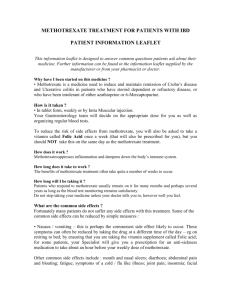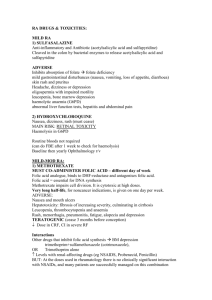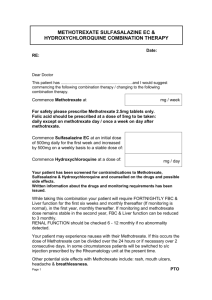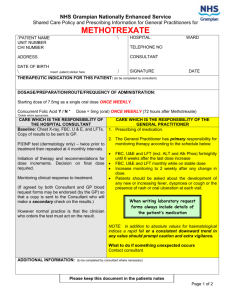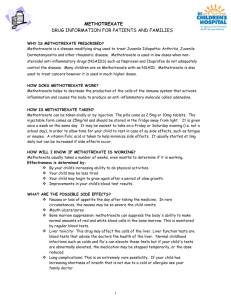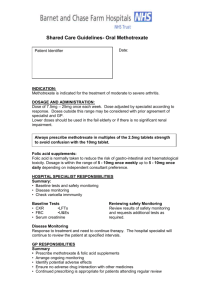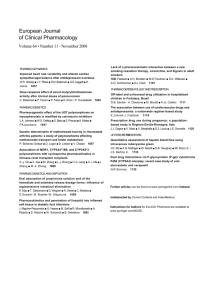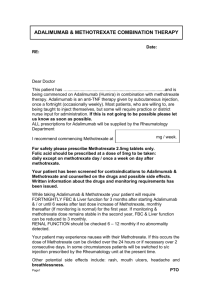Methotrexate
advertisement
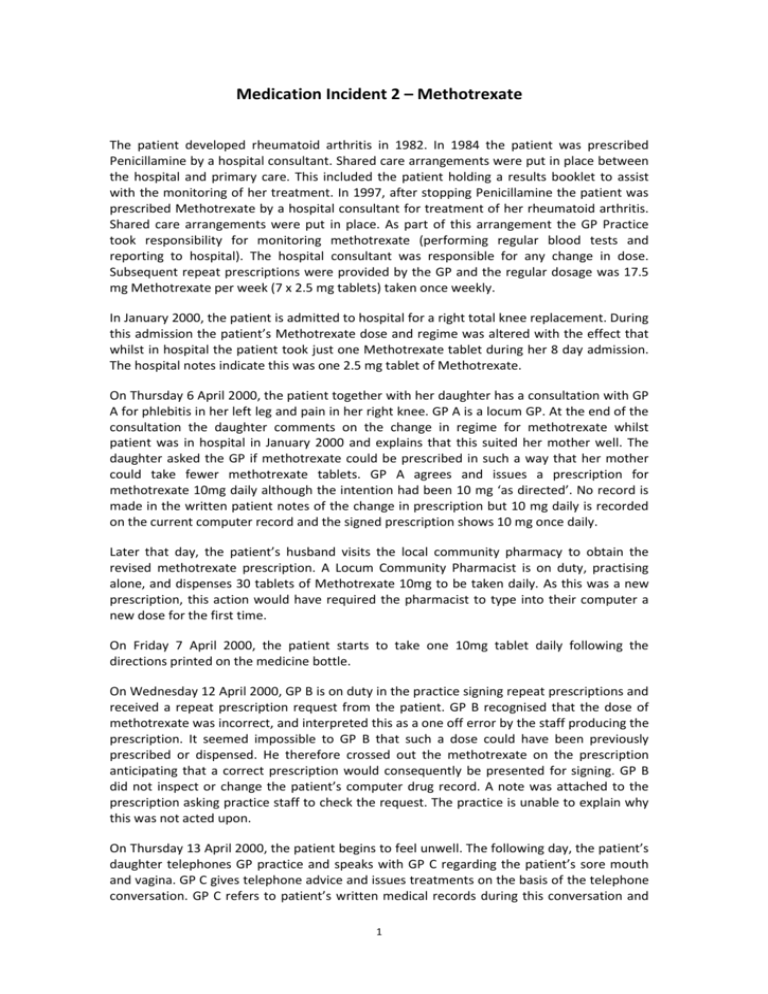
Medication Incident 2 – Methotrexate The patient developed rheumatoid arthritis in 1982. In 1984 the patient was prescribed Penicillamine by a hospital consultant. Shared care arrangements were put in place between the hospital and primary care. This included the patient holding a results booklet to assist with the monitoring of her treatment. In 1997, after stopping Penicillamine the patient was prescribed Methotrexate by a hospital consultant for treatment of her rheumatoid arthritis. Shared care arrangements were put in place. As part of this arrangement the GP Practice took responsibility for monitoring methotrexate (performing regular blood tests and reporting to hospital). The hospital consultant was responsible for any change in dose. Subsequent repeat prescriptions were provided by the GP and the regular dosage was 17.5 mg Methotrexate per week (7 x 2.5 mg tablets) taken once weekly. In January 2000, the patient is admitted to hospital for a right total knee replacement. During this admission the patient’s Methotrexate dose and regime was altered with the effect that whilst in hospital the patient took just one Methotrexate tablet during her 8 day admission. The hospital notes indicate this was one 2.5 mg tablet of Methotrexate. On Thursday 6 April 2000, the patient together with her daughter has a consultation with GP A for phlebitis in her left leg and pain in her right knee. GP A is a locum GP. At the end of the consultation the daughter comments on the change in regime for methotrexate whilst patient was in hospital in January 2000 and explains that this suited her mother well. The daughter asked the GP if methotrexate could be prescribed in such a way that her mother could take fewer methotrexate tablets. GP A agrees and issues a prescription for methotrexate 10mg daily although the intention had been 10 mg ‘as directed’. No record is made in the written patient notes of the change in prescription but 10 mg daily is recorded on the current computer record and the signed prescription shows 10 mg once daily. Later that day, the patient’s husband visits the local community pharmacy to obtain the revised methotrexate prescription. A Locum Community Pharmacist is on duty, practising alone, and dispenses 30 tablets of Methotrexate 10mg to be taken daily. As this was a new prescription, this action would have required the pharmacist to type into their computer a new dose for the first time. On Friday 7 April 2000, the patient starts to take one 10mg tablet daily following the directions printed on the medicine bottle. On Wednesday 12 April 2000, GP B is on duty in the practice signing repeat prescriptions and received a repeat prescription request from the patient. GP B recognised that the dose of methotrexate was incorrect, and interpreted this as a one off error by the staff producing the prescription. It seemed impossible to GP B that such a dose could have been previously prescribed or dispensed. He therefore crossed out the methotrexate on the prescription anticipating that a correct prescription would consequently be presented for signing. GP B did not inspect or change the patient’s computer drug record. A note was attached to the prescription asking practice staff to check the request. The practice is unable to explain why this was not acted upon. On Thursday 13 April 2000, the patient begins to feel unwell. The following day, the patient’s daughter telephones GP practice and speaks with GP C regarding the patient’s sore mouth and vagina. GP C gives telephone advice and issues treatments on the basis of the telephone conversation. GP C refers to patient’s written medical records during this conversation and 1 records action in those notes; however electronic computer based prescription records were not referred to. On Saturday 15 April 2000, the General Practice receives a request for home visit to the patient. GP C, the doctor on duty, visits and offers to arrange patient’s admission to hospital. This is declined by the patient and her family. It is agreed the practice would telephone the patient on Monday if the family have not called sooner. The home visit is conducted with no patient notes to refer to which would be usual practice for a Saturday. GP C makes contemporaneous notes which were stuck into the patient’s medical notes on the following Monday. On Monday 17 April 2000, GP A visits patient at home (following a request) and takes patient notes. Patient has sore throat and inflammation in her groin area. On Tuesday 18 April 2000, there is message for GP A from daughter that patient’s condition has worsened. GP A contacts the daughter and discusses patient’s condition over the telephone. GP A arranges admission to a hospital ENT ward because patient’s main symptoms related to her sore throat. GP A has a telephone conversation with Dr D, an ENT junior doctor, at the hospital. GP A faxes Dr D information relevant to the patient’s admission. This fax was not received by Dr D and not followed up. The fax contained no specific reference to methotrexate, but did indicate that the patient would “bring all medication with her’. At 4.00pm: patient admitted to hospital by Dr D who recorded patient history and drugs brought in by patient (Patient Own Drugs – PODs). Methotrexate 10 mg was noted in the drug history but the frequency was not recorded. Dr D also completed a drugs chart which included a prescription for 100 mg of methotrexate daily. As methotrexate is not held as a stock drug on the ENT ward, the ward decided to use the patient’s own drug which is within hospital procedure. In addition, blood tests were ordered. The full blood count was not analysed by the laboratory, as the sample was not satisfactory. During the night Dr E reviews patient, notes the blood test had been unsuccessful as it had clotted. Dr E takes a second blood sample and sends off to laboratory. On Wednesday 19 April 2000 at 3.37 am the test on the second blood sample was reported on by the laboratory, when it was recorded as “insufficient for testing, please repeat”. During the morning drug round, Staff Nurse F notes 100mg Methotrexate daily recorded on the patient’s drug chart. Staff Nurse F realised this dose must be incorrect and confirmed with the patient that this should be 10 mg daily. Staff Nurse F then administered 10mg. Staff Nurse F leaves a post-it note for ENT SHO to amend the drug chart. No change is made by SHO on this day. On Thursday 20 April 2000, Staff Nurse G is responsible for drugs round and notices prescription for Methotrexate 100mg whereas drug bottle marked 10 mg. Staff Nurse G checks with patient, notes Staff Nurse F administered 10 mg. Written ‘post-it’ note for ENT SHO to amend drug chart still attached. Drug chart sent down to Pharmacy later that morning for other drugs that the patient needed. At lunchtime the hospital pharmacy queries methotrexate on receipt of patient’s drug chart. Hospital Pharmacist H realises methotrexate 100mg is wrong and crosses methotrexate off drug chart. Pharmacist H tells Staff Nurse F that the doctor needs to clarify the correct and intended dose. Staff Nurse F passes message to Dr D who telephoned the GP Surgery to check dose and someone (not a GP) at the surgery confirms the dose as 10mg per day after checking the computer records. Dr D amends the dose on the prescription chart to re-prescribe 10 mg Methotrexate once per 2 day. Dr D asks Staff Nurse F why she had not been asked to amend the prescription earlier. Staff Nurse F explained that she had written a note but that this had not been seen and was no longer attached to the drug chart. On Friday 21 April 2000 (Good Friday), during the ward round, doctors thought the patient’s condition much improved. By this stage patient has been reviewed by two Specialist Registrars (SpRs) and two Senior House Officers (SHOs) during her stay but no evidence yet of consultant review. Ibuprofen was stopped but other drugs not obviously considered. Methotrexate 10mg dose administered. On Saturday 22 April 2000, Staff Nurse G notes patient had developed a rash over her trunk. The senior nurse on duty asks Staff Nurse G to review the patient’s medication in the BNF. Staff Nurse G contacts Dr E and suggests that methotrexate might be the cause of the patient’s problems. Dr E said he thought this was unlikely, however said he would review the patient when he was available and arrives to see the patient 40 minutes later. Dr E examines the patient and reviews the drug history. Notes blood count results are still outstanding and need to be chased. A third blood sample taken which reveals abnormalities (low blood platelets and low white blood cells). Arrangements are made to transfer the patient to the specialist haematologist team. On Sunday 23 April 2000, a Haematology/oncology doctor explains poor prognosis to relative(s) On Wednesday 26 April 2000, the patient’s daughter contacts Cambridgeshire Health Authority Complaints Department. On Sunday 30 April 2000, the patient dies. Death certificates show causes of death to have been Gastrointestinal haemorrhage Pancytopaenia Methotrexate toxicity 3
